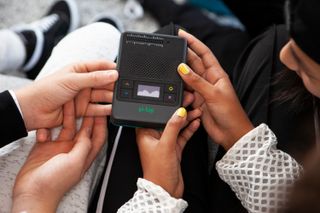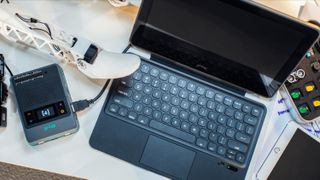Raspberry Pi 4 Mobile PC, Pi-Top 4, Starts Pre-Orders on Kickstarter
Now’s a better time than ever to start tinkering with Raspberry Pi. The latest iteration, the Raspberry Pi 4, brings unprecedented capabilities with up to four times the memory of its predecessor, a speedier GPU and better port selection, making it nothing less than a full mini computer.
The pi-top [4] takes advantage of the extra slice of oomph, putting the Pi 4 into an adorable case that turns the single board computer into a mobile PC. Today, the pi-top [4] Kickstarter is launching with a $100,000 fundraising goal and promise to fill orders in November 2019, according to pi-top CEO and co-founder Jesse Lozano.

The pi-top [4] targets maker projects that demand mobility, like weather balloons, drones or even a robot. Pi-top bringing the product to consumers through a crowdfunder, after successful Indiegogo campaigns for its tablet-like pi-topCEED and laptop-like pi-top [3] (both powered by the Raspberry Pi 3).
Backers can get a pi-top [4] for $199, a price that won’t be seen again, Lozano said. Each pi-top [4] comes with a 16GB SD card pre-loaded with the pi-topOS, a power supply, Ethernet cable and hex key.
Larger bids get you various pi-top [4] accessories, including a programmable autonomous rover, the pi-top [AVK] for advanced vehicle kit. It features 20 metal building plates and over 100 components, including servos, sensors tracks and wheels.
“It can be a low-profile rover with a camera to fit in a tiny space, a farm bot to sow seeds or look for weeds or you could go in a completely different direction and create a robot that uses machine vision to sort different objects according to color or size,” Lozano mused.

The pi-top [4] has a small programmable OLED screen for displaying information like sensor readings, CPU usage and battery life. But the Kickstarter has an option to add an 11.6- inch 1080p resolution touchscreen monitor that you can connect via HDMI, plus a detachable Bluetooth keyboard. But don’t think of the monitor as a way to kick back and watch videos. In fact, full screen videos on YouTube at 1080p look jerky on the Pi 4 (it gets better at 480p). Instead, the monitor is for maker projects that demand output for user interaction, like a robot with an interactive face or a vivid photo booth display.
Stay on the Cutting Edge
Join the experts who read Tom's Hardware for the inside track on enthusiast PC tech news — and have for over 25 years. We'll send breaking news and in-depth reviews of CPUs, GPUs, AI, maker hardware and more straight to your inbox.
“The build and user interaction quality of the screen and keyboard is the best we have ever made. It easily competes with the build quality of any big brand device,” Lozano said.
There are plans for future pi-top [4] accessories in 2020 and beyond, including from third-party developers.
For Kickstarter Skeptics
Lozano acknowledged the skepticism that can come with crowdfunding products but pointed to Kickstarter as being “well-established” and allowing fun interaction with the community.
He added that the company will provide “regular updates with more insight and detail than you would normally get from the average campaign.”
“If you want to really see and learn how a product is made, this is the campaign for you,” he said.
Skeptics may also take solace in knowing pi-top has already successfully shipped over 250,000 devices worldwide, according to the CEO.
MORE: Raspberry Pi GPIO Pinout: What Each Pin Does
MORE: How to Use Raspberry Pi as a VPN Gateway
MORE: Raspberry Pi Tutorials
Scharon Harding has a special affinity for gaming peripherals (especially monitors), laptops and virtual reality. Previously, she covered business technology, including hardware, software, cyber security, cloud and other IT happenings, at Channelnomics, with bylines at CRN UK.
Most Popular






